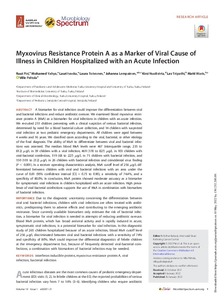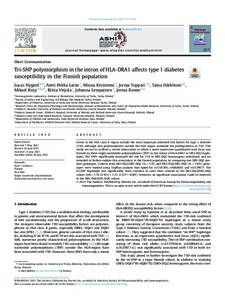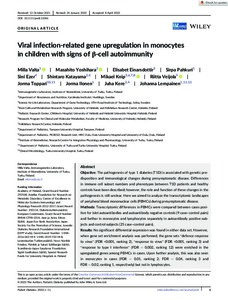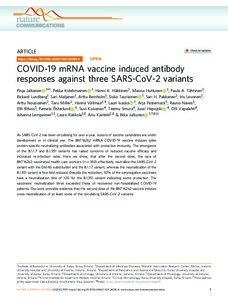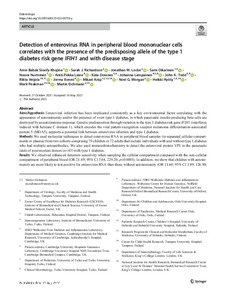Hae
Aineistot 1-10 / 13
Myxovirus Resistance Protein A as a Marker of Viral Cause of Illness in Children Hospitalized with an Acute Infection
<p>A biomarker for viral infection could improve the differentiation between viral and bacterial infections and reduce antibiotic overuse. We examined blood myxovirus resistance protein A (MxA) as a biomarker for viral infections in children with an acute infection. We recruited 251 children presenting with a clinical suspicion of serious bacterial infection, determined by need for a blood bacterial culture collection, and 14 children with suspected viral infection at two pediatric emergency departments. All children were aged between 4 weeks and 16 years. We classified cases according to the viral, bacterial, or other etiology of the final diagnosis. The ability of MxA to differentiate between viral and bacterial infections was assessed. The median blood MxA levels were 467 (interquartile range, 235 to 812) μg/L in 39 children with a viral infection, 469 (178 to 827) μg/L in 103 children with viral-bacterial coinfection, 119 (68 to 227) μg/L in 75 children with bacterial infection, and 150 (101 to 212) μg/L in 26 children with bacterial infection and coincidental virus finding (P < 0.001). In a receiver operating characteristics analysis, MxA cutoff level of 256 μg/L differentiated between children with viral and bacterial infections with an area under the curve of 0.81 (95% confidence interval [CI] = 0.73 to 0.90), a sensitivity of 74.4%, and a specificity of 80.0%. In conclusion, MxA protein showed moderate accuracy as a biomarker for symptomatic viral infections in children hospitalized with an acute infection. High prevalence of viral-bacterial coinfections supports the use of MxA in combination with biomarkers of bacterial infection.<br></p>...
Long-Lasting T Cell Responses in BNT162b2 COVID-19 mRNA Vaccinees and COVID-19 Convalescent Patients
<p>The emergence of novel variants of the severe acute respiratory syndrome coronavirus 2 (SARS-CoV-2) has made it more difficult to prevent the virus from spreading despite available vaccines. Reports of breakthrough ...
Tri-SNP polymorphism in the intron of HLA-DRA1 affects type 1 diabetes susceptibility in the Finnish population
<p>Genes in the HLA class II region include the most important inherited risk factors for type 1 diabetes (T1D) although also polymorphisms outside the HLA region modulate the predisposition to T1D. This study set out to ...
Non-HLA Gene Polymorphisms in the Pathogenesis of Type 1 Diabetes: Phase and Endotype Specific Effects
The non-HLA loci conferring susceptibility to type 1 diabetes determine approximately half of the genetic disease risk, and several of them have been shown to affect immune-cell or pancreatic beta-cell functions. A number ...
Viral infection-related gene upregulation in monocytes in children with signs of β-cell autoimmunity
Objective: The pathogenesis of type 1 diabetes (T1D) is associated with genetic predisposition and immunological changes during presymptomatic disease. Differences in immune cell subset numbers and phenotypes between T1D ...
Childhood manifestations of 22q11.2 deletion syndrome: A Finnish nationwide register-based cohort study
<p>Aim<br>The aim of the study was to describe the clinical manifestations of 22q11.2 deletion syndrome patients in the Finnish paediatric population.</p><p>Methods<br>Nationwide registry data including all diagnoses and ...
Low pre-vaccination SARS-CoV-2 seroprevalence in Finnish health care workers: a prospective cohort study
<p><strong>Background: </strong>Health care workers are at risk of acquiring SARS-CoV-2 infection. Our aim was to study the prevalence of SARS-CoV-2 nucleoprotein and spike protein specific antibodies in health care workers ...
HLA-DR-DQ haplotypes and specificity of the initial autoantibody in islet specific autoimmunity
<p>Objective<br>We aimed to clarify the association of various HLA risk alleles with different types of autoantibodies initiating islet specific autoimmunity.</p><p>Methods<br>Follow-up cohorts from the Finnish Type 1 ...
COVID-19 mRNA vaccine induced antibody responses against three SARS-CoV-2 variants
<p>As SARS-CoV-2 has been circulating for over a year, dozens of vaccine candidates are under development or in clinical use. The BNT162b2 mRNA COVID-19 vaccine induces spike protein-specific neutralizing antibodies ...
Detection of enterovirus RNA in peripheral blood mononuclear cells correlates with the presence of the predisposing allele of the type 1 diabetes risk gene IFIH1 and with disease stage
<p><b>Aims/hypothesis</b> Enteroviral infection has been implicated consistently as a key environmental factor correlating with the appearance of autoimmunity and/or the presence of overt type 1 diabetes, in which pancreatic ...
